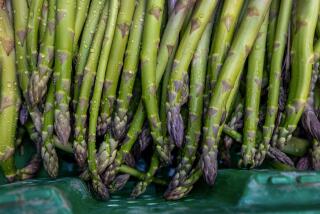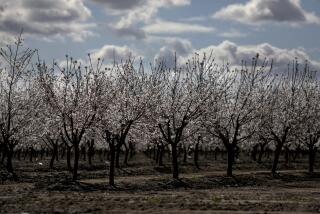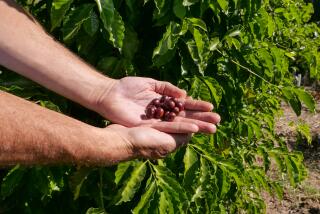Farmers Markets: California keeps its sweet spot in macadamias
- Share via
FALLBROOK — Jim Russell’s macadamia orchard looks like a park, 3 acres of holly-like evergreens growing above closely cropped grass. A casual observer would never suspect that it represents a relic of a bygone boom, a source of uniquely delicious nuts and one man’s triumph over paralysis.
Macadamias are native to eastern Australia, where there are two edible species: integrifolia in warmer areas and tetraphylla in cooler. The kind brought to Hawaii in 1881, and first commercialized there, was integrifolia, which proved most productive and suitable for roasting. It’s the standard around the world.
Macadamia was introduced to California about the same time but not planted commercially until the 1950s, when it was promoted as a replacement for avocado trees with root rot, since it is resistant to that disease. Growers selected primarily tetraphylla and hybrid varieties adapted to the cooler climate, with slightly oval nuts that are sweeter and richer in flavor than integrifolia. Plantings peaked in 1987 at 625 acres, and boosters still claim there are thousands more. But profits proved elusive, and as costs for water, labor and land increased, acreage in San Diego County, the main growing area, dwindled to 67 in 2011, according to the local agricultural commissioner’s count.
Russell was part of the boom, with a twist.
Russell was born on a farm in Pennsylvania in 1941, joined the Marine Corps at 17 and served three tours of duty in Vietnam, rising to the rank of major. He married, had five children and divorced. Then one terrible night in 1977, his motorcycle veered off the edge of a road and slid on gravel. His head hit a cement culvert, his spinal cord was severed and he was paralyzed from the waist down.
After seven months in a rehabilitation hospital, he retired with a disability pension, married his fiancée, Barbara, and started working on a master’s in business administration at San Diego State University. As part of his studies, he researched the economics of local macadamia cultivation and decided to start his own orchard. Amazingly, he planted the trees himself, from a wheelchair. He even put up gutters on his house using a scaffold.
“I just needed to know, for me, that I could do that,” he said on a recent tour of his orchard.
In order to move about the grove, he slid along a board from his wheelchair into a golf cart modified to allow hand operations, handling the maneuver with military gruffness.
He acknowledged that he was in pain most of the time. “Nothing I can’t handle,” he said.
Beyond the bravado, there’s a gentle side to him, evident when he cradles his service dog, Beau, a rescued pug that accompanies him everywhere, picking up items on command that Russell can’t reach.
Russell employs two local teenagers, Tony and Jesus Lopez, who harvest the ripe macadamias off the ground into buckets. Most are of the Cate variety, derived from a tetraphylla seedling selected in Malibu in 1958 and the most prevalent variety in California.
After the harvest, in a workroom at Russell’s home, the Lopez brothers pour the nuts into a huller that rasps off the green, fibrous husks. They then spread the brown whole nuts on racks to dry for two weeks at room temperature and five days at 94 degrees. That brings the moisture down to 1%, so the kernels become crunchy. The shells are rock hard, but an artfully rigged device incises them and extracts the kernels, which Russell himself grades and bags.
The macadamia harvest is weekly from late October to mid-February and irregularly the rest of the year. Russell sells every other week through mid-June at the Wednesday Santa Monica farmers market, next on Jan. 23. About three-quarters of the nuts are shelled, costing up to $12.50 a pound for large, whole, premium nuts. These are best stored in the freezer or refrigerator. He also offers unshelled nuts, which are so hard that they require a specially designed nutcracker to open. Many of his sales go to raw food aficionados and vegans, who prize the nuts as a source of healthful fat and for flavor and texture.
Russell has served since 1988 as president of the California Macadamia Society, established in 1953, which holds an annual field day and puts out a yearbook. He has served on the state Certified Farmers Market Advisory Board and is on the board of the national Paralyzed Veterans of America (PVA). He runs shooting skills programs for the PVA and for the U.S. Olympic Committee.
“We’ve been the No. 1 team for the past five years,” he said with a wry smile. “We show the able side of disabled.”
It’s rare to find California macadamias at supermarkets, since imported nuts are available more cheaply. Only a few large macadamia orchards remain in California, but there are a lot of small growers with just five to 10 trees. Many of them bring their crop to the Gold Crown Macadamia Assn., a cooperative based in Escondido that has 350 members and markets 60,000 pounds of in-shell nuts a year, said Dan Hecko, the group’s manager. Some customers buy the nuts to feed to their exotic birds, and one farm in Fallbrook uses them to fatten pigs, supposedly imparting an especially delicious flavor to the pork.
Hawaii, for many years the world’s largest producer and marketer of macadamias, now has 17,000 acres, accounting for 14% of the global crop, according to a recent article in HortScience. Australia is the world’s largest grower and exporter, with 36% of the harvest. Growers in South Africa, Malawi and Kenya have established huge plantings in recent decades, and Africa produces a surprising 40%. California, which at one point looked like it could have been a contender, accounts for less than 0.01%. But although other areas can produce greater tonnage per acre, none can provide a sweeter, more delicious nut.
More to Read
Eat your way across L.A.
Get our weekly Tasting Notes newsletter for reviews, news and more.
You may occasionally receive promotional content from the Los Angeles Times.










